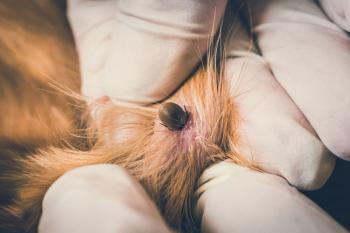
Foaling: The fight for immunity
Making sure ... there is passive transfer of antibodies (IgG) is critical to maintain immunity.
Because foals are often born within the early hours of the morning, farm personnel need to be observant and call if the necessity arises. In some circumstances, soon after parturition, an emergency arises. In other situations, the newborn foal looks okay, and then shows signs of illness within a few hours or days.
This article takes a comprehensive look at the science and art of foaling.
"I usually start doing my neonatal exam within the first moments after birth, even before they get up," says Laurie Metcalfe, DVM, Rood & Riddle Equine Hospital. "If not that soon, we might get a call in the morning if the foal has been born overnight, so the exam might be within six hours or so. By that time the foal might have had a chance to stand and nurse. If I'm there at the birthing, I will examine them right away."
If seen close after birth, their overall appearance is important, its behavior is even more critical, as signs of illness usually are in the way it acts during the first few hours of life. Early observation is key, experts say.
"It is important to watch them to see if they are giving you any clues that something may be wrong," Metcalfe explains. Can they right themselves, are they strong, making attempts to get up. Do they have a suckle reflex?
"You kind of get a feel if they are acting right or not," Metcalfe notes. "It comes with experience. One of the most important things that I have learned is that catching things early is critical." So is referring early. "Some of these foals that have had a hypoxic insult during birth might look fine at 12 hours to 24 hours, but at 36 hours they'll turn into 'dummy' foals. If you begin to recognize that earlier, and have them on antibiotics, and have someone monitoring them closely, it can make a world of difference."
It is important to watch the foal's mentation to see if they look bright and alert. You can look at a foal and notice that it is not aware of its surroundings. They might periodically fade in and out of awareness. They may go off to a corner of the stall and not know where the mare is. That is a concern. "The foal should constantly be at the teat. If it periodically wanders off, and is disinterested in nursing that alarms me," Metcalfe cautions.
Much needs to occur within the first two to three hours. They should immediately recognize the mare and begin to bond with her. They need to have the suckle reflex and want to nurse. You want them to suckle even before they are getting up. "I like to see them attempt to get up during the first half an hour," Metcalfe adds.
Right after birth, the newborn foal should have a heart rate greater than 60 beats per minute. Foals should spontaneously begin to breath although some will need tactile stimulation to wake up. In the first 30 seconds after the foal is born, the foal will take gasping breaths. The normal respiratory rate during the first five minutes is 40 to 60 breaths per minute. Once the foal is three hours old, its respiratory rate lowers to 30 to 40 breaths per minute with minimal breathing effort. The foal's heart rate will increase to around 100-130 beats per minute.
"It should all be just happening," says Katherine MacGillivray, VMD, Dipl. ACVIM, Hagyard Equine Medical Institute. "If you don't see the normal sequence of foal activities and behaviors after birth, there is concern regarding the foal's well being." They should usually stand within the first hour, and often suckle the air or straw prior to actually latching onto the mare. Foals should nurse from the mare within two to three hours of birth. At times foals are unable to coordinate both standing and nursing without minimal assistance. During the normal sequence, soon after they first fill their stomach, they will pass the meconium, the first feces. Ideally, a foal passes meconium within eight hours.
The foal that demonstrates normal nursing behavior soon after birth can still have changes in mentation, nursing behavior and overall comfort several hours after birth.
There are several reasons a foal may not be nursing. Is it colicky? Is the animal straining to defecate and pass meconium? Straining to urinate? A foal may attempt to nurse repeatedly, not because it is hungry, but because it does not know what else to do.
Some foals may have difficulty nursing in that the suckle reflex is not coordinated. "I usually try and see if a foal will suck at my finger," says MacGillivray. However, sometimes foals will only suckle from a mare and you cannot judge the foal's suckling ability in this way. If the foal is truly unable to suckle, is aimlessly wandering the stall and/or disoriented, there is concern the foal may be a dummy foal. The term HIE (hypoxic ischemic encephalopathy) refers injury secondary to lack of adequate oxygen delivery to the brain. More recently, the term perinatal asphyxia syndrome (PAS) has been preferred as it encompasses other body systems such as the kidneys and GI tract in addition to the brain. There is a wide variation in signs of PAS, from mildly depressed to having frequent seizures. Although the exact mechanism is not fully understood, there appears to be certain regions within the brain that are most commonly affected. Mildly affected foals may remain on the farm for treatment depending on the type of farm and available personnel. The more severely affected cases are usually treated at a clinic due to the high level of nursing care and need for alternate forms of nourishment.
Diarrhea seen within a couple of days can be the result of PAS and a lack of adequate oxygen delivery to the intestinal tract. Any foal that has hypoxia, maybe a red-bag foal, an hypoxic insult as it was being born, and one that it's just not coming back from it real well. A red-bag delivery occurs when the fetal membranes do not rupture and the placenta is separating from the uterus. You will see a red velvety structure appearing at the vulva. This structure must be carefully and quickly opened, and the foal delivered. Once the placenta separates, the foal cannot get oxygen and will die unless it can breathe.
"We see variations of the dummy foal," MacGillivray agrees. In the hospital, some foals are down, on the mattresses, requiring IV fluids, TPN (intravenous nutrition), frequent turning and other intensive care. There is another group of ill foals that are managed on the farm, especially to maintain them there as opposed to the hospital. "Ideally, if you can manage them on the farm by placing a feeding tube, that's better," MacGillivray suggests.
Making sure that the foals get adequate colostrum and that there is passive transfer of their antibodies (IgG) is critical to maintain immunity, Metcalfe adds. There are three things that would prevent passive transfer — the colostrum is not adequate, the foal does not consume a sufficient quantity of colostrum, or that the foal has an inability to absorb the colostrum. At about 8 hours to 12 hours, a blood sample is taken to monitor its IgG level. If not, plasma is administered via IV. Without it, the foal is in jeopardy, since there is no placental transfer of immunoglobulins. The foal is also deprived of placental transfer of vitamin E. The message: the colostrum is necessary to provide it and other fat-soluble nutrients, such as beta-carotene and vitamin D. Foals should gain weight progressively. They weigh about 50 kg at birth, and should put on about 1 kilogram per day.
Most farms in Central Kentucky do a well-foal blood check which usually includes a complete blood count and IgG at 12 hours of age. "If possible, I think it is important to also check the creatinine level," says MacGillivray. Creatinine can be increased in normal foals especially following a dystocia. However, the increase can also be secondary to kidney damage due to PAS or as a result of treatments such as tetracycline for angular limb deformities.
As foals absorb the immunoglobulins from the colostrum, they test the IgG level at 12 hours, when they still have a bit of time to tube them with some more colostrum. In other parts of the country, it may be done at the 24-hour mark, as there is some discussion whether it is absorbed within a 12- to 24-hour period. For well-managed farms, 400-800 mg/dl IgG is probably in the acceptable range. If a foal is insured, most insurance companies require an IgG level of at least 600 while many farms prefer an IgG of 800 mg/dl. Failure of passive transfer is defined as an IgG level of less than 400 mg/dl. If the foal's level is less than desired and depending on the timing of the blood sampling, the foal will be given colostrum by a nasogastric tube or given intravenous plasma and the IgG re-checked. In sick foals, more than 1 liter of plasma may be required to attain an adequate IgG level.
Next month: The series continues with a discussion on wellness and health problems for foals.
Newsletter
From exam room tips to practice management insights, get trusted veterinary news delivered straight to your inbox—subscribe to dvm360.




